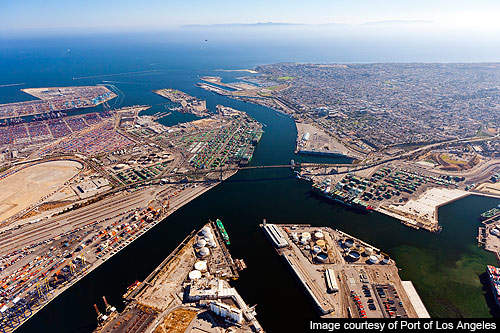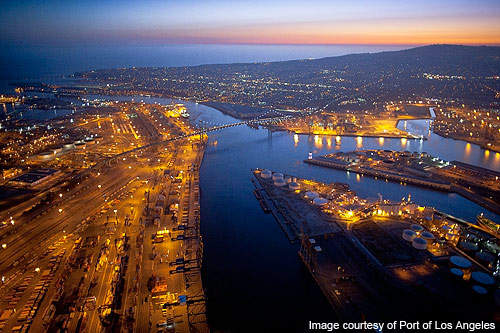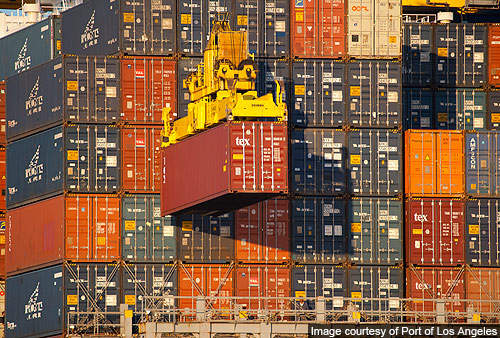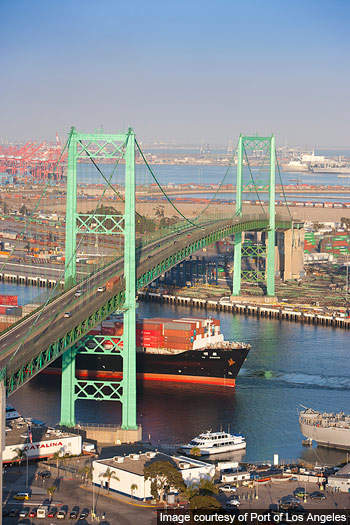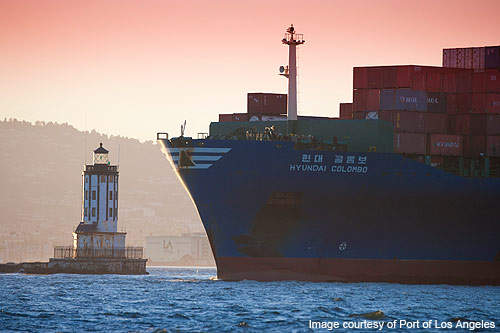The Port of Los Angeles is located in San Pedro Bay, approximately 32km south of downtown Los Angeles. Officially founded in 1907, the port has become one of the premier seaports of America and is considered as southern California’s gateway to international commerce.
For the last decade, it has consecutively been ranked as number one port (in terms of container throughput) in the country.
In the last ten years, the volume of operations at the port has doubled. The cargo terminals handled 7.8 million TEUs in 2010.
The Port of Los Angeles was discovered as the ‘Bay of Smokes’ by Juan Rodriguez Cabrillo in 1542. The port celebrated its 50th anniversary in 1957 and centennial in 2007.
Los Angeles port design
The Port of Los Angeles covers 4,300 acres of land and 3,200 acres of water along 69km of waterfront. With a water depth of 53ft, the port can accommodate the largest container ships in the world.
The automobile terminal (berths 195-199) has a total land area of 85 acres and total berth length of 2,250ft. Alongside depths range from 32ft to 34ft.
Berth 100 (west basin container terminal) covers 75 acres. Total berth length is 1,200ft and water depth ranges between 45 to 53ft.
The west basin container terminal at berths 121 to 131 occupies 186 acres of land. Total berth length is 3,500ft and alongside depths vary from 35 to 45ft.
Total land area of container terminal at berths 135 through 139 is 173 acres. Total berth length is 4,050ft and alongside depths 35ft to 53ft.
Berths 206 through 209 are designated as the Port of Los Angeles container terminal. It has a total land area of 86 acres.
The total land area of the yusen terminal (berths 212-225) is 185 acres. Its total berth length is 5,800ft and alongside depths 35 to 45ft.
The total land area of APL terminal / global gateway south is 292 acres, APM terminals / pier 400 is 484 acres and California united terminals is 91 acres.
The World Cruise Center passenger terminal has a total land area of 18 acres, total berth length of 2,850ft and water depth of 37ft. The length of the concourse is 1,102ft and width of the navigational channel is 1,000ft.
Construction of the Port of Los Angeles
In 1871, the main channel was dredged to 10ft and breakwater was built between Rattlesnake Island and Deadman’s Island.
The main channel was extended to 800ft and dredged to 30ft in 1911-12. The first 8,500ft section of the breakwater was also completed during that year.
The middle breakwater was extended by 18,500ft in 1937. The port’s first container terminal was constructed in 1960 at a cost of $1.8m. The main channel was dredged to 45ft in 1983.
The dredging and landfill programme for pier 400, which began in 1994, was completed in 2000. The global gateway south container terminal and terminal island container transfer facility were opened in 1997.
Terminal expansion
Construction on the final phase of the $370m main channel deepening project (MCDP) was restarted in July 2010 after a delay of five years. The project, which began more than a decade ago, was put on hold in 2005 after port officials discovered 13 potential dirt disposal sites. The project is scheduled for completion in 2013.
China Shipping, which operates the west basin container terminal at the port, completed a major phase of its terminal expansion project in April 2011. The $47.6m expansion project added a new 925ft section of wharf and 18 additional acres of back land.
Port of Los Angeles facilities
The facilities of Port of Los Angeles are spread over 7,500 acres of land. The port features an automobile terminal, two break bulk cargo terminals, nine container terminals, two dry bulk terminals, seven liquid bulk terminals and two passenger terminals.
The west basin container terminal features transtainers, tophandlers, sidehandlers, forklifts and on-dock rail facility.
The trans Pacific container terminal has a 28,000ft² maintenance shop, 546 reefer plugs, 48 grounded plugs, three portable generators, four toplifts, ten transtainers, 12 side-handlers and wash system for exterior as well as interior of containers.
The main features of yusen terminal include 21,937ft² administration / in-gate building, 23,386ft² maintenance and repair building, and 4,798ft² marine building. California united terminals, APM terminals, APL terminal / global gateway south and seaside terminal are the other terminals.
The passenger terminal features two terminal buildings. It also has three passenger processing areas, and a US Customs security clearance and baggage handling facility. Passenger shuttles and overnight parking are provided at the terminal.
All the container terminals are equipped with post-Panamax cranes and Panamax cranes.
Operator
The Port of Los Angeles is managed and operated by the Los Angeles Board of Harbor Commissioners, established in 1907. A five-member Board of Harbor Commissioners is appointed by the Mayor and sanctioned by the Los Angeles City Council.
The west basin container terminal is operated by West Basin Container Terminal LLC. The container terminal at berths 135 through 139 is operated by TransPacific Container Service Corporation (TraPac).
The seaside terminal at berths 226 through 236 is operated by Seaside Transportation Services. APL Terminals operates global gateway south terminal and pier 400 is operated by APM Terminals. Some of the other operators of the port facilities include Stevedoring Services of America, Pasha Group, Kinder Morgan, ConocoPhillips, Nustar Energy, ExxonMobil and Shell.
Los Angeles Port security
The Port of Los Angeles is considered as one of the securest seaports in the world. The 300-member Los Angeles Port Police force ensures safety by monitoring the waterfront and land-based facilities. The port also uses 24/7 threat detection and incident management systems.

